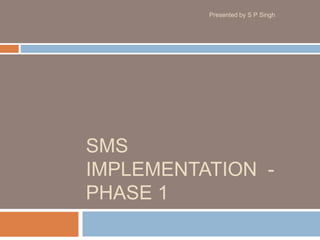
Sms Implementation Phase 1
- 1. SMS IMPLEMENTATION - PHASE 1 Presented by S P Singh
- 2. Plan for Implementation Presented by S P Singh Phase 1: Before 20th November 2010 Phase 2: At one-year (20.07.2011) Phase 3: Two years (20.07.20120) Phase 4: One year following phase 3,
- 3. Phase 1 Presented by S P Singh Before 20th November 2010 a) name of the accountable executive; b) name of the person responsible for implementing the SMS; c) a statement of commitment to the implementation of SMS (signed by the AE); d) documentation of a gap analysis between the organization’s existing system and the SMS regulatory requirements; and e) the organization’s implementation project plan based on an internal gap analysis
- 4. DEFINITIONS Presented by S P Singh Accountable Executive is the single, identifiable person having final responsibility for the effective and efficient performance of the organization’s SMS Gap analysis - a gap analysis is basically an analysis of the safety arrangements already existing within the organization as compared to those necessary for the SMS to function.
- 5. Accountable Executive: Presented by S P Singh The Accountable Executive shall be a single, identifiable person who, irrespective of other functions, shall have ultimate responsibility and accountability, for the implementation and maintenance of the SMS.
- 6. safety manager Presented by S P Singh responsible for the implementation and maintenance of an effective SMS. ensure that processes needed for the SMS are developed, implemented adhered to and maintained; report to the Accountable Executive on the performance of the SMS
- 7. SAFETY POLICY Presented by S P Singh Safety is a core business value, and a fundamental component of our competitive advantage. Our organization is strengthened by making continuous safety improvements and excellence an integral part of all our activities. All managers and employees are responsible and accountable for their actions and safety Performance, starting with myself as Managing Director.
- 8. SAFETY POLICY Presented by S P Singh I endorse all personnel to think and work safely at all times, regardless of any real or perceived pressures to do otherwise. To prevent accidents and to eliminate damage or injury, we have implemented and maintain an active safety management system (SMS). Our objective is the proactive management of identifiable hazards, the reduction of risk to a level as low as reasonably practicable, and the sharing of safety information.
- 9. safety management systems manual Presented by S P Singh a) scope of the safety management system; b) safety policy and objectives; c) safety accountabilities; d) key safety personnel; e) documentation control procedures; f) coordination of emergency response planning;
- 10. SMSM Presented by S P Singh g) hazard identification and safety risk management schemes; h) safety performance monitoring; i) safety auditing; j) procedures for the management of change; k) safety promotion; and l) control of contracted activities.
- 11. Hazard identification Presented by S P Singh a) reporting of hazards, events or safety concerns; b) collection and storage of safety data; c) analysis of the safety data; and d) distribution of the safety information distilled from the safety data
- 12. Safety performance monitoring and measurement Presented by S P Singh Safety performance monitoring and measurement means shall include the following: a) hazard reporting systems; b) safety audits; c) safety surveys; d) safety reviews; e) safety studies; and f) internal safety investigations
- 13. Safety communication Presented by S P Singh a) ensure that all staff are fully aware of the SMS; b) convey safety-critical information; c) explain why particular safety actions are taken; d) explain why safety procedures are introduced or changed; and e) convey generic safety information
- 14. Safety communication Presented by S P Singh Formal means of safety communication shall include inter alia: a) safety policies and procedures; b) newsletters; c) bulletins; and d) websites